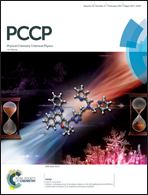A tailored multi-frequency EPR approach to accurately determine the magnetic resonance parameters of dynamic nuclear polarization agents: application to AMUPol†
Abstract
To understand the dynamic nuclear polarization (DNP) enhancements of biradical polarizing agents, the magnetic resonance parameters need to be known. We describe a tailored EPR approach to accurately determine electron spin–spin coupling parameters using a combination of standard (9 GHz), high (95 GHz) and ultra-high (275 GHz) frequency EPR. Comparing liquid- and frozen-solution continuous-wave EPR spectra provides accurate anisotropic dipolar interaction D and isotropic exchange interaction J parameters of the DNP biradical AMUPol. We found that D was larger by as much as 30% compared to earlier estimates, and that J is 43 MHz, whereas before it was considered to be negligible. With the refined data, quantum mechanical calculations confirm that an increase in dipolar electron–electron couplings leads to higher cross-effect DNP efficiencies. Moreover, the DNP calculations qualitatively reproduce the difference of TOTAPOL and AMUPol DNP efficiencies found experimentally and suggest that AMUPol is particularly effective in improving the DNP efficiency at magnetic fields higher than 500 MHz. The multi-frequency EPR approach will aid in predicting the optimal structures for future DNP agents.



 Please wait while we load your content...
Please wait while we load your content...